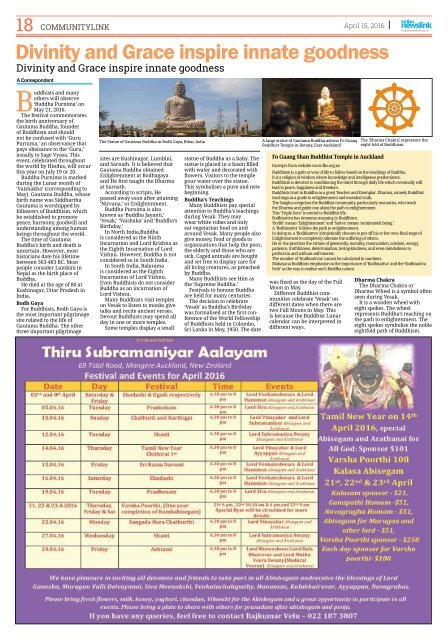Create successful ePaper yourself
Turn your PDF publications into a flip-book with our unique Google optimized e-Paper software.
18 COMMUNITYLINK<br />
<strong>April</strong> <strong>15</strong>, <strong>2016</strong><br />
Divinity and Grace inspire innate goodness<br />
Divinity and Grace inspire innate goodness<br />
A Correspondent<br />
Buddhists and many<br />
others will observe<br />
‘Buddha Purnima’ on<br />
May 21, <strong>2016</strong>.<br />
The festival commemorates<br />
the birth anniversary of<br />
Gautama Buddha, founder<br />
of Buddhism and should<br />
not be confused with ‘Guru<br />
Purnima,’ an observance that<br />
pays obeisance to the ‘Guru,’<br />
usually to Sage Vyasa. This<br />
event, celebrated throughout<br />
the world by Hindus, will occur<br />
this year on July 19 or 20.<br />
Buddha Purnima is marked<br />
during the Lunar month of<br />
‘Vaishakha’ (corresponding to<br />
May). Gautama Buddha, whose<br />
birth name was Siddhartha<br />
Gautama is worshipped by<br />
followers of Buddhism, which<br />
he established to promote<br />
peace, harmony, goodwill and<br />
understanding among human<br />
beings throughout the world.<br />
The time of Gautama<br />
Buddha’s birth and death is<br />
uncertain. However, most<br />
historians date his lifetime<br />
between 563-483 BC. Most<br />
people consider Lumbini in<br />
Nepal as the birth place of<br />
Buddha.<br />
He died at the age of 80 at<br />
Kushinagar, Uttar Pradesh in<br />
India.<br />
Bodh Gaya<br />
For Buddhists, Bodh Gaya is<br />
the most important pilgrimage<br />
site related to the life of<br />
Gautama Buddha. The other<br />
three important pilgrimage<br />
The Statue of Gautama Buddha in Bodh Gaya, Bihar, India<br />
sites are Kushinagar, Lumbini,<br />
and Sarnath. It is believed that<br />
Gautama Buddha obtained<br />
Enlightenment at Bodhagaya<br />
and He first taught the Dharma<br />
at Sarnath.<br />
According to scripts, He<br />
passed away soon after attaining<br />
‘Nirvana,’ or Enlightenment.<br />
Buddha Purnima is also<br />
known as ‘Buddha Jayanti,’<br />
‘Vesak,’ ‘Vaishaka’ and ‘Buddha’s<br />
Birthday.’<br />
In North India,Buddha<br />
is considered as the Ninth<br />
Incarnation and Lord Krishna as<br />
the Eighth Incarnation of Lord<br />
Vishnu. However, Buddha is not<br />
considered so in South India.<br />
In South India, Balarama<br />
is considered as the Eighth<br />
Incarnation of Lord Vishnu.<br />
Even Buddhists do not consider<br />
Buddha as an incarnation of<br />
Lord Vishnu.<br />
Many Buddhists visit temples<br />
on Vesak to listen to monks give<br />
talks and recite ancient verses.<br />
Devout Buddhists may spend all<br />
day in one or more temples.<br />
Some temples display a small<br />
statue of Buddha as a baby. The<br />
statue is placed in a basin filled<br />
with water and decorated with<br />
flowers. Visitors to the temple<br />
pour water over the statue.<br />
This symbolises a pure and new<br />
beginning.<br />
Buddha’s Teachings<br />
Many Buddhists pay special<br />
attention to Buddha’s teachings<br />
during Vesak. They may<br />
wear white robes and only<br />
eat vegetarian food on and<br />
around Vesak. Many people also<br />
give money, food or goods to<br />
organizations that help the poor,<br />
the elderly and those who are<br />
sick. Caged animals are bought<br />
and set free to display care for<br />
all living creatures, as preached<br />
by Buddha.<br />
Many Buddhists see Him as<br />
the ‘Supreme Buddha.’<br />
Festivals to honour Buddha<br />
are held for many centuries.<br />
The decision to celebrate<br />
‘Vesak’ as Buddha’s Birthday<br />
was formalised at the first conference<br />
of the World Fellowship<br />
of Buddhists held in Colombo,<br />
Sri Lanka in May, 1950. The date<br />
A large statue of Gautama Buddha adorns Fo Guang<br />
Buddhist Temple in Botany, East Auckland<br />
Fo Guang Shan Buddhist Temple in Auckland<br />
Excerpts from website www.fbs.org.nz<br />
Buddhism is a path or way of life to follow based on the teachings of Buddha.<br />
It is a religion of wisdom where knowledge and intelligence predominate.<br />
Buddhism is devoted to conditioning the mind through daily life which eventually will<br />
lead to peace, happiness and freedom.<br />
Buddhists trust in Buddha as a great Teacher and Exemplar. Dharma, namely Buddhist<br />
teachings as a guide to enlightenment and essential truth.<br />
The Sangha comprises the Buddhist community, particularly monastics, who teach<br />
the Dharma and guide one along the path to enlightenment.<br />
This ‘Triple Gem’ is central to Buddhist life.<br />
Bodhisattva has immense meaning in Buddhism.<br />
‘Bodhi’ means ‘Enlightenment’ and ‘Sattva’ means ‘sentimental being.’<br />
A ‘Bodhisattva’ follows the path to enlightenment.<br />
In doing so, a ‘Bodhisattva’ altruistically chooses to put off his or her own final stage of<br />
Enlightenment to completely alleviate the suffering of others.<br />
He or she practices the virtues of generosity, morality, renunciation, wisdom, energy,<br />
patience, truthfulness, determination, loving-kindness, and even-mindedness to<br />
perfection and without self-interest.<br />
The number of ‘Bodhisattvas’ cannot be calculated in numbers.<br />
Mahayana Buddhists emphasise on the importance of ‘Bodhisattva’ and the ‘Bodhisattva<br />
Path’ as the way to realise one’s Buddha nature.<br />
was fixed as the day of the Full<br />
Moon in May.<br />
Different Buddhist communities<br />
celebrate ‘Vesak’ on<br />
different dates when there are<br />
two Full Moons in May. This<br />
is because the Buddhist Lunar<br />
calendar can be interpreted in<br />
different ways.<br />
The ‘Dharma Chakra,’ represents the<br />
eight-fold of Buddhism<br />
Dharma Chakra<br />
The Dharma Chakra or<br />
Dharma Wheel is a symbol often<br />
seen during Vesak.<br />
It is a wooden wheel with<br />
eight spokes. The wheel<br />
represents Buddha’s teaching on<br />
the path to enlightenment. The<br />
eight spokes symbolise the noble<br />
eightfold path of Buddhism.


















